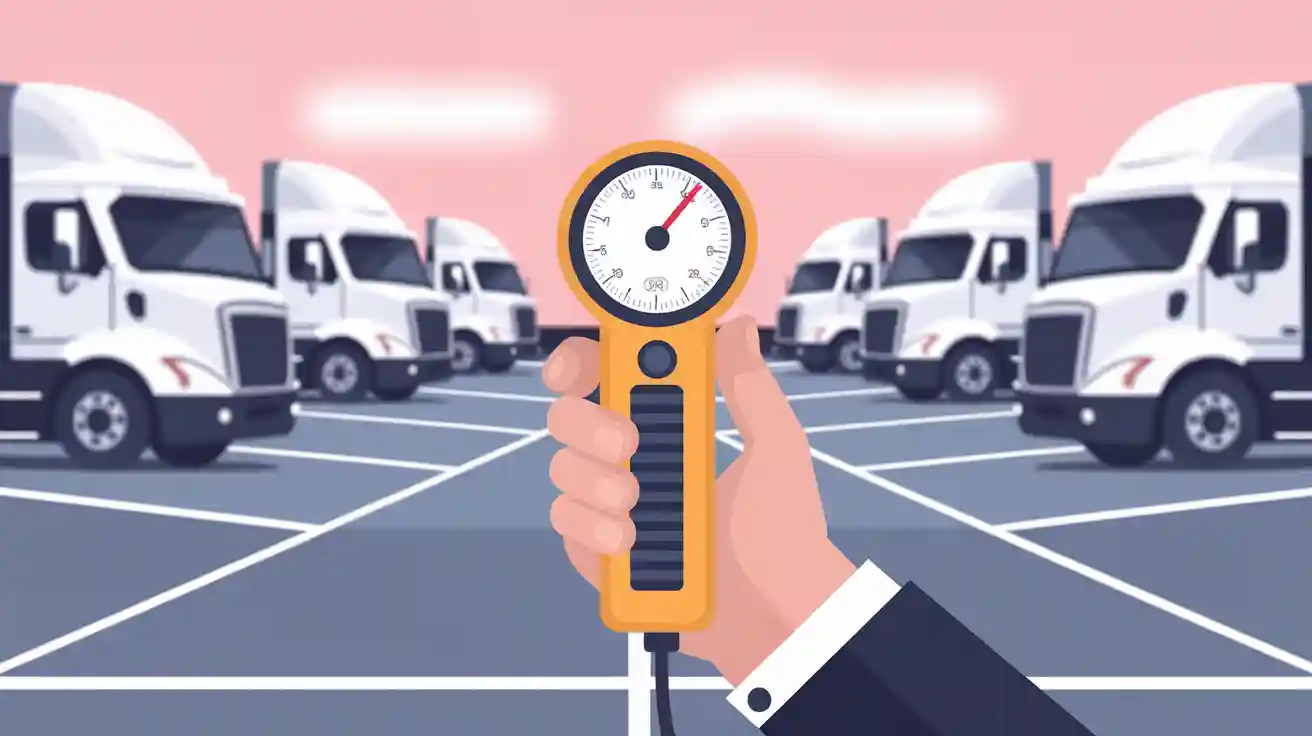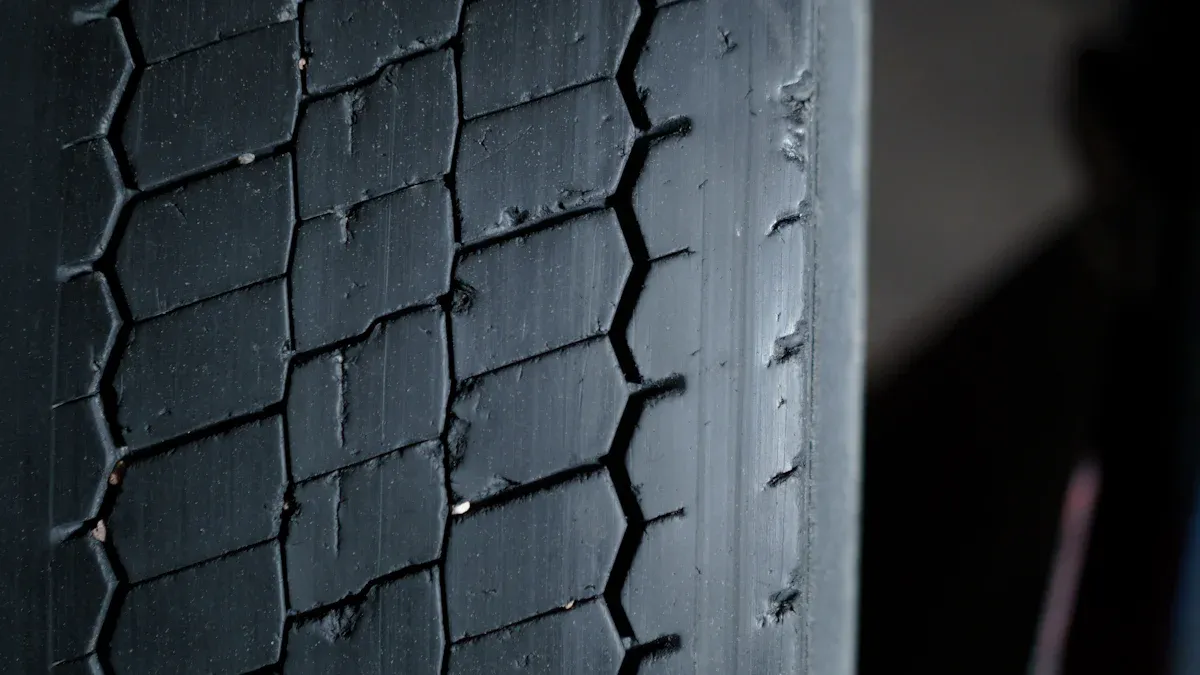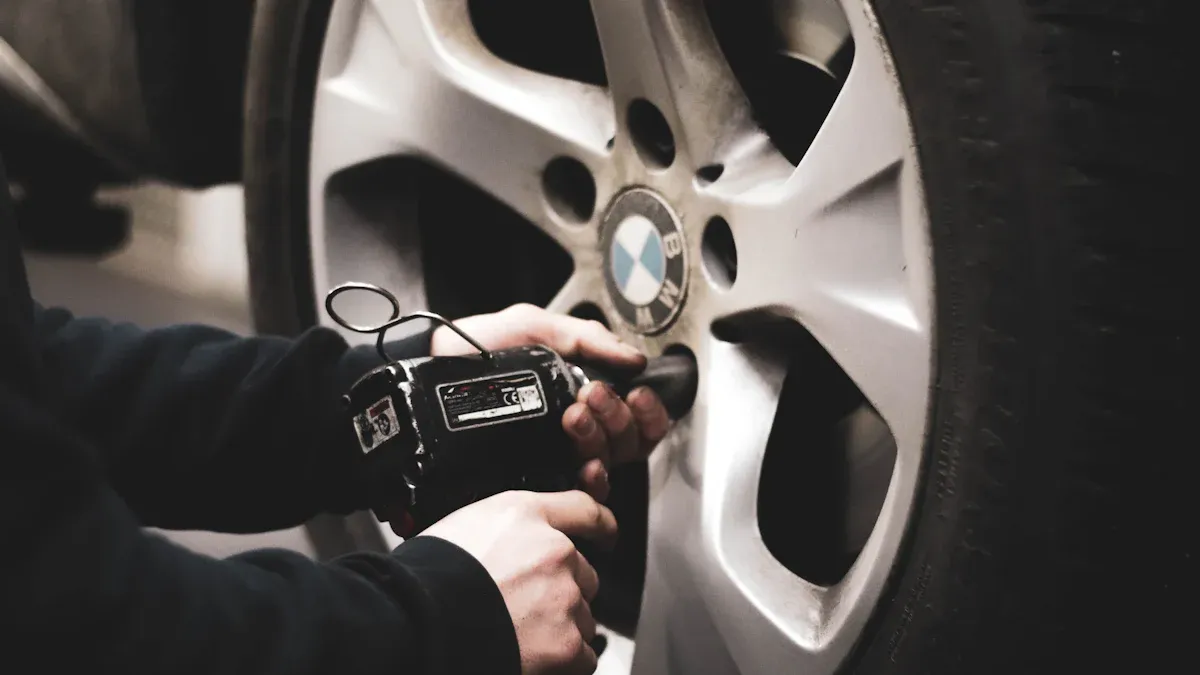
A blowout can cause big money losses. Some cases lead to over $100,000 in cargo damage. Keeping tires healthy is very important for fleet management. When tires are in good shape, they help with braking and turning. This lowers the chances of accidents. Tire blowouts cause about 8,000 trucking accidents every year in the U.S. This shows how tire health connects to truck blowout cargo loss. To lower these risks, fleet owners can use a handheld tire tread depth gauge. This tool helps make sure tires have the right tread depth. It keeps drivers safe and cuts down on expensive blowouts.
Βασικά Συμπεράσματα
Check tire tread depth often with a handheld gauge. This helps stop blowouts and cargo loss.
Know that bad tire inflation and too much weight cause blowouts. Keep tires inflated right and within weight limits.
Make a maintenance plan. This should include daily checks before trips and routine checks every 5,000-10,000 miles. This helps find problems early.
Follow the tread depth rules for safety. Change tires when the tread depth is 2/32 inch or less.
Buy tire management tools. They help improve safety, lower costs, and boost fleet performance.
Financial Impact of Blowouts
Cargo Loss Overview
A blowout can cause big money losses for fleet owners. When a tire blows out, it can damage cargo worth over $100,000. This loss affects not just your money but also how your fleet runs. You will have costs from damaged items, possible legal issues, and higher maintenance bills.
The most common reasons for tire blowouts are:
Cause of Tire Blowout | Περιγραφή |
|---|---|
Improperly Inflated Tires | 90% of commercial tire blowouts happen because tires are not inflated enough, causing more friction and wear. |
Overloading | Carrying too much weight puts too much pressure on tires, raising the chance of blowouts. |
Road Hazards | Hitting curbs and potholes often can weaken tires, causing them to fail. |
Poor Maintenance | Not taking care of tires can lead to sudden failures, stressing drivers and fleet managers. |
Knowing these causes helps you take steps to stop blowouts and the cargo loss that comes with them.
Real-World Examples
Think about a real case where a fleet owner had a blowout while moving expensive electronics. The blowout happened because the tires were under-inflated, causing a cargo loss of $150,000. This not only caused money loss but also delayed deliveries, hurting customer satisfaction.
Another case is a food distribution company. A tire blowout delayed the delivery of perishable goods. The company lost $80,000 because of spoiled items and fines for being late. These examples show why keeping tires healthy is important to avoid cargo loss from blowouts.
Fleet owners also need to know about legal issues. If a blowout causes cargo loss, you might get liability claims. Reports say most blowouts happen because of negligence. Regular tire checks and maintenance can help lower this risk.
“Most blowouts are the result of negligence. Fleet owners and drivers need to inspect their tires regularly and ensure that they are installed correctly. Failure to care for the parts of the truck can increase the risk of a crash; it also opens them to liability.”
Liability can involve many people, like the truck driver, the fleet owner, and the tire maker. If more than one party is at fault, damages may be shared based on negligence laws.
By knowing how blowouts affect finances and taking steps to prevent them, you can keep your fleet safe from costly cargo losses.
Σημασία του Βάθους Πελμάτων Ελαστικών

Tread Depth and Safety
Το βάθος πέλματος ελαστικού είναι πολύ σημαντικό for your fleet’s safety. If the tread depth is too low, it can cause serious problems. This includes blowouts and losing control of the vehicle. When the tread depth is low, tires cannot grip the road well. This makes hydroplaning more likely, which can lead to losing steering and braking control.
Here are some main dangers of low tread depth:
Hydroplaning: Low tread depth raises the risk of hydroplaning, causing loss of steering and braking control.
Excessive heat buildup: Low tread can create too much heat, leading to tire blowouts and loss of vehicle control.
Blowouts: Tires with low tread are more likely to blow out, which can be deadly, especially at high speeds.
Difficulty stopping: Worn tires make it harder to stop, increasing the chance of accidents.
Low air pressure: Worn tires lose air quickly, which reduces grip and control.
Regular checks and early warnings from tread scanners can help you avoid problems with worn tires that may lead to blowouts. The Department of Transportation (DOT) says that front tires must have a minimum tread depth of 4/32 of an inch. Other tires must have at least 2/32 of an inch. Tires that do not meet these standards are more likely to blow out, especially in bad weather.
Recommended Standards
To keep safe and perform well, you need to follow the recommended minimum tread depth standards. Here’s a quick look at the standards:
Τύπος Ελαστικού | Ελάχιστο Βάθος Πέλματος |
|---|---|
Steer Tires | 4/32 της ίντσας |
Άλλα Ελαστικά | 2/32 της ίντσας |
CVSA Steer Tires | >2/32 in two adjacent grooves |
CVSA Other Tires | ≥1/32 in two adjacent grooves at three locations |
Regulatory agencies enforce these standards to keep your fleet safe. For example, the Commercial Vehicle Safety Alliance (CVSA) requires a minimum tread depth of 2/32nds for the front axle and 1/32nd for other axles. If your vehicle is below these minimums, it can be taken off the road until repairs are done. The Federal Motor Carrier Safety Administration (FMCSA) has similar rules, needing 4/32 inch for steering axles and 2/32 inch for other tires.
By keeping the right tread depth, you improve safety and lower the risk of truck blowout cargo loss. Taking care of your tires helps you avoid expensive accidents and keeps your fleet running smoothly.
Using a Handheld Tire Tread Depth Gauge

Proper Usage
Using a handheld tire tread depth gauge is easy and works well. Follow these steps to get correct measurements:
Extend the measuring probe on the gauge all the way out.
Place the probe into the tread groove. Make sure it does not touch tread wear indicators or raised areas. Push down on the gauge’s base.
Check the measurement is above 1.6mm by looking at the analogue scale or the digital display.
Take measurements around the whole tire and across the middle three-quarters of its width.
Do this for each tire.
Avoid common mistakes to improve accuracy. Always take several measurements across the tire tread. Relying on just one measurement can lead to wrong results. Make sure you measure around the whole tire and focus on the middle three-quarters of the tire’s width for the best results.
Benefits of Precision
Using a handheld tire tread depth gauge has many benefits compared to visual checks. Here’s a comparison of features:
Χαρακτηριστικό | Περιγραφή |
|---|---|
±1% + 0.0012 inch (0.03 mm) | |
Measurement Capability | Measures inner, center, and outer tread depth |
Importance | Ensures reliable data for tire health assessment |
Accurate readings from these gauges help you replace tires on time. This keeps safety high and gives chances for more tire sales and service hours. Regular checks help you avoid costly violations and keep safety on the road. The simple design lets drivers and maintenance staff check easily.
Monitoring tire health electronically leads to quick actions. Accurate tread depth measurements improve a vehicle’s grip on the road, help braking on wet surfaces, and lower the risk of aquaplaning. This keeps drivers and passengers safe, greatly reducing the risk of truck blowout cargo loss.
Regular Tire Inspections
Maintenance Schedule
Adding regular tire checks to your maintenance plan is very important for keeping your fleet safe and running well. You should do different types of inspections at certain times to keep tires in good shape. Here’s a suggested schedule:
Inspection Type | Συχνότητα |
|---|---|
Pre-Trip Inspections | Daily |
Routine Maintenance Inspections | Every 5,000-10,000 miles |
Quarterly Professional Inspections | Every 3 months |
Regular checks help you find problems early. This way, you can avoid expensive breakdowns and stay safe. You should also check tire pressure and tread wear during trips. Mechanics need to do alignment and brake tests often. Older vehicles need more checks. Change your maintenance plans based on company needs and how each vehicle performs. Teaching drivers about tire care is very important. Make sure to allow time for pre-trip checks to keep everyone safe.
Εξοικονόμηση Κόστους
Τακτικοί έλεγχοι και υπηρεσίες ελαστικών can save fleet owners a lot of money. Tires are one of the biggest costs for fleets, right after fuel and driver pay. By starting a regular inspection program, you can save thousands each year. Here are some main benefits:
Key Benefit | Περιγραφή |
|---|---|
Extended Tire Life | Regular checks help find problems early, which makes tires last longer. |
Βελτιωμένη Αποδοτικότητα Καυσίμου | Well-kept tires help vehicles run better, leading to less fuel use. |
Prevention of Costly Repairs | Finding tire wear early stops expensive replacements and cuts down on downtime. |
By taking care of your tires well, you can lower common issues like uneven wear and damage. Accurate, real-time tire inspection data can greatly help your budget and improve safety. As one expert said, “Creating a smart tire management plan will help control costs and give a good return.” Regular inspections not only make things safer but also help your fleet work better and make more money.
In conclusion, keeping tires healthy is very important for fleet safety and how well things run. Checking tire tread depth often can greatly lower the chances of blowouts and cargo loss. Research shows that about 9% of crashes are caused by tire problems. Vehicles with worn-out tread have a 26% chance of having an accident, while those with good tread only have a 2.4% chance.
To stay safe, you should:
Check tire tread depth regularly using a tire tread measurer or the penny test.
Replace tires when tread depth is 2/32 inch or less to avoid longer stopping distances and hydroplaning.
Make it a habit to check tires every month to catch problems early.
Buying tools like a handheld tire tread depth gauge not only makes things safer but can also lower your insurance costs. As Brian Silva from Uptake says, “We have shown that Tire Insights are useful and greatly reduce the risk of tire failures and their costs.” By focusing on good tire management, you can keep your fleet safe and improve your profits.
Συχνές ερωτήσεις
What is a handheld tire tread depth gauge?
A handheld tire tread depth gauge is a tool that measures the depth of tire tread. You can use it to ensure your tires meet safety standards and maintain optimal performance.
Πόσο συχνά πρέπει να ελέγχω το βάθος πέλματος των ελαστικών μου;
You should check your tire tread depth at least once a month. Regular checks help you catch wear early and prevent blowouts.
What happens if my tire tread is too low?
If your tire tread is too low, you risk blowouts, hydroplaning, and reduced vehicle control. This can lead to accidents and costly cargo loss.
Can I use a penny to check tire tread depth?
Yes, you can use a penny for a quick check. Insert the penny into the tread. If you see Lincoln’s head, your tread is too low and needs replacement.
How can regular tire inspections save money?
Regular tire inspections can extend tire life, improve fuel efficiency, and prevent costly repairs. This proactive approach helps you avoid unexpected breakdowns and expenses.
Δείτε επίσης
Χρησιμοποιώντας μετρητή βάθους πέλματος ελαστικού για ακριβείς μετρήσεις
Η σημασία της παρακολούθησης του βάθους πέλματος ελαστικών για την ασφάλεια
Κατανόηση των Έξυπνων Ανιχνευτών Βάθους Πέλματος Ελαστικού και η Λειτουργικότητά τους






